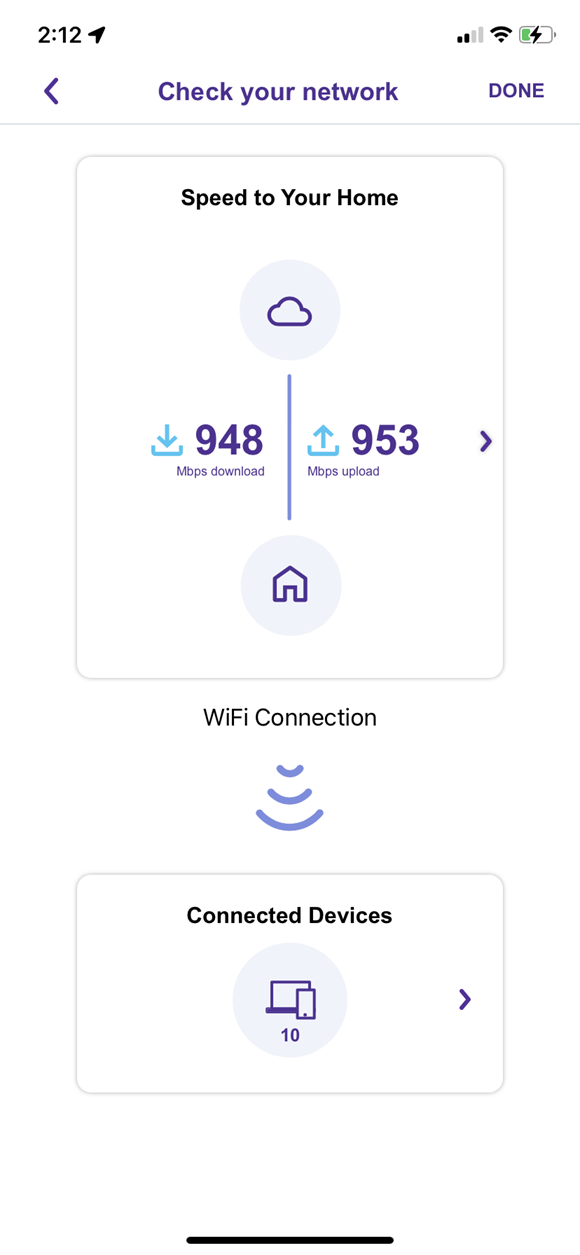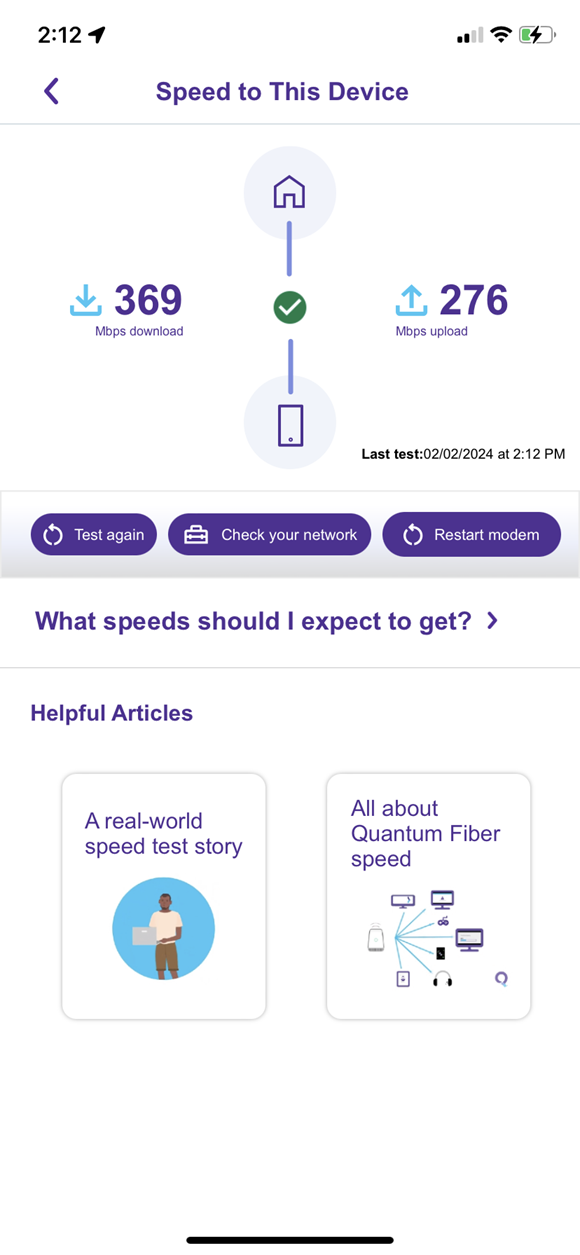All about Quantum Fiber speed
Get your speed questions answered here! From what your speed test tells you to how to get the best speed possible, learn more about fiber internet and WiFi speeds.
Speed basics
This table shows the bandwidth needed for common online activities. To determine how much total bandwidth you need, add all the activities you want to do simultaneously in your home or business.
Online activity |
Recommended bandwidth* |
| Streaming music | 2 Mbps |
| Browsing the web, email, social media, shopping | 3 Mbps |
SD video streaming |
3 Mbps |
HD video streaming |
5 Mbps |
| HD video chatting | 10 Mbps |
| File downloads | 10 - 50 Mbps |
4K video streaming |
15 Mbps |
| HD online gaming | 25 Mbps |
Remote work/learning |
50 Mbps |
| 4K online gaming | 100 Mbps |
Large file downloads (e.g. game files) |
100 - 150 Mbps** |
* Indicates minimum recommended bandwidth required for each device to perform this activity. Each device activity takes away from total available bandwidth.
** Higher bandwidth is recommended for very large files to reduce download times. For instance, some games can be 60 GB or more.
You may hear these two terms used interchangeably, but they are a bit different:
- Bandwidth is the amount of data transmitted over an internet connection per second.
- Speed (or throughput) to the device is the rate at which content reaches any one device (tablet, laptop, smartphone, etc.) from the internet at any one moment.
Think about a water pipe that supplies water to a building. Bandwidth is the size of the pipe, which determines how much water can flow through the pipe in a second. The speed is how fast the water comes out of one tap when you turn it on.
Depending on your location, we offer plans of up to 1 Gbps, 3 Gbps, and 8 Gbps, as measured from the Quantum Fiber network to the SmartNID modem. With incredible numbers like these, the benefits come down to three major factors:
Massive bandwidth. You can connect an unlimited number of bandwidth-hungry devices and run everything at once without seeing slowdowns. And even as you add more smart devices and use more bandwidth in the future, your internet connection won’t suffer.
Ultra-fast speeds. Due to device limitations, you are unlikely to see your plan speed on any one device, but the incredible potential is real. Plans with up to 3 Gbps are measured at 15 times faster than the average U.S. download speed, with 8 Gbps clocking in at 40 times faster. So you can download and upload large files in seconds or minutes, and quickly back up data for every device without stepping on the speed on your other devices.
Low latency. Every video you stream, every multi-player game you play, every videoconference you host, or even several at once—can be done simultaneously without affecting each other’s performance.
This table shows the bandwidth needed for common online activities. To determine how much total bandwidth you need, add all the activities you want to do simultaneously in your home or business.
Online activity |
Recommended bandwidth* |
| Streaming music | 2 Mbps |
| Browsing the web, email, social media, shopping | 3 Mbps |
SD video streaming |
3 Mbps |
HD video streaming |
5 Mbps |
| HD video chatting | 10 Mbps |
| File downloads | 10 - 50 Mbps |
4K video streaming |
15 Mbps |
| HD online gaming | 25 Mbps |
Remote work/learning |
50 Mbps |
| 4K online gaming | 100 Mbps |
Large file downloads (e.g. game files) |
100 - 150 Mbps** |
* Indicates minimum recommended bandwidth required for each device to perform this activity. Each device activity takes away from total available bandwidth.
** Higher bandwidth is recommended for very large files to reduce download times. For instance, some games can be 60 GB or more.
You may hear these two terms used interchangeably, but they are a bit different:
- Bandwidth is the amount of data transmitted over an internet connection per second.
- Speed (or throughput) to the device is the rate at which content reaches any one device (tablet, laptop, smartphone, etc.) from the internet at any one moment.
Think about a water pipe that supplies water to a building. Bandwidth is the size of the pipe, which determines how much water can flow through the pipe in a second. The speed is how fast the water comes out of one tap when you turn it on.
Depending on your location, we offer plans of up to 1 Gbps, 3 Gbps, and 8 Gbps, as measured from the Quantum Fiber network to the SmartNID modem. With incredible numbers like these, the benefits come down to three major factors:
Massive bandwidth. You can connect an unlimited number of bandwidth-hungry devices and run everything at once without seeing slowdowns. And even as you add more smart devices and use more bandwidth in the future, your internet connection won’t suffer.
Ultra-fast speeds. Due to device limitations, you are unlikely to see your plan speed on any one device, but the incredible potential is real. Plans with up to 3 Gbps are measured at 15 times faster than the average U.S. download speed, with 8 Gbps clocking in at 40 times faster. So you can download and upload large files in seconds or minutes, and quickly back up data for every device without stepping on the speed on your other devices.
Low latency. Every video you stream, every multi-player game you play, every videoconference you host, or even several at once—can be done simultaneously without affecting each other’s performance.
Speed test results
Your test results will include download and upload speeds, plus ping.
| Download speed (Mbps or Gbps) |
How fast data is transferred from the network to your device |
| Upload speed (Mbps or Gbps) |
How fast data is transferred from your device to the network |
| Ping, latency Milliseconds (ms) |
The time it takes for a packet of data to travel to the server and back to your device |
There are several factors that impact the real-world speeds you get at any given time on your devices.
Your devices: No matter how fast the internet service, devices have their own speed limits. Many devices will be slower than your core connection speed, especially when you're running at gigabit speeds. For example, some laptops only support 100 or 200 Mbps. You’ll see the best performance on devices made in the past two years.
More device factors that can impact speed include processor type or operating system, your web browser version, security firewalls, and anti-virus software. Learn more about online security and why it's essential to good performance.
Number of devices: All devices connected to your network share the finite amount of bandwidth. The beauty of super-high bandwidth like our multi-gig plans is that sharing across several devices is less likely to impact device speed.
WiFi factors: Your wireless connection can greatly impact your speed. The farther away a device is from the nearest WiFi pod or router, the slower the real-time speed will be. Physical barriers like walls, floors and doors that stand in between will also cut signal strength. And WiFi networks that overlap yours can cause interference and reduce speeds as well.
Speed plans indicate the maximum total bandwidth you will get from our network to your modem. Depending on where you live, you may have a speed package of up to 200 Mbps, 500 Mbps, 940 Mbps, 1 Gbps, 3 Gbps or 8 Gbps.
The speeds you see from device to device will vary quite a bit based on several factors. Check out Omar's speed story to get a better sense of what's normal under different conditions. For instance, connecting over WiFi results in a slower data speed than a wired connection.
Internet speeds are not guaranteed due to conditions outside of network control, including your location, type and age of devices, other equipment used, and use of a wireless connection. See our internet policy for more information.
Maximize your speed
Yes. To get the best possible speed and performance from your Quantum Fiber service, we strongly recommend using the gateway modem provided by Quantum Fiber or our SmartNID with 360 WiFi. If you're thinking of using your own router, there are some things to know about how this can impact your performance.
The speed-to-device test in the app (and on our website) measures the speed on the specific mobile phone, tablet, or computer you use to run the test. This reflects only a portion of your overall bandwidth. Device speeds tend to vary a lot, as they're impacted by factors like the type and age of your device, the number of devices connected to your network, your equipment, and WiFi signal interference.
On the other hand, the speed-to-home test in the Quantum Fiber app should be very close to your total plan bandwidth, as it reflects the signal directly from our fiber network to your SmartNID or modem. This number remains pretty steady most of the time.


Check out Omar's speed story to get a sense of how you can expect device speeds to vary in different conditions.
If you're gettings slower speeds than you expect, try these steps:
- Restart your SmartNID or modem. You can restart from the Quantum Fiber app or manually. This will help clear the memory and can reset a sluggish connection.
- Try to clear a path from your WiFi pod or modem to your core devices. Avoid physical blocks like heavy walls, floors, or appliances as much as possible.
- If you have a bandwidth-hungry device, especially on a 200 Mbps plan, consider disconnecting that device at certain times of day. Or connect over Ethernet instead of WiFi to get a reliable connection without drawing on the WiFi network.
- If you have frequency options, connect using 5 GHz WiFi for higher speeds.
- Keep devices, operating systems, and apps up to date. For the best WiFi speeds, use devices made within the last few years.
- Make sure devices are protected with good security software to prevent malware from slowing things down.
Still having slow connection problems? Follow the additional tips here:
Video: What impacts speed
VIDEO 2:50
Related topics
Was this information helpful?








